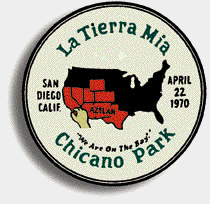Chicano Park
| Chicano Park | |
|---|---|

Chicano Park logo, originally by Rico Bueno. La Tierra Mía means "My Land".
|
|
| Location | Logan Heights, San Diego, California |
| Area | 32,000 square meter |
| Created | April 22, 1970 |
| Operated by |
Chicano Park Steering Committee |
|
Chicano Park
|
|
| NRHP Reference # | 12001192 |
| SDHL # | 143 |
| Significant dates | |
| Added to NRHP | January 23, 2013 |
| Designated NHL | December 23, 2016 |
| Designated SDHL | March 7, 1980 |
Chicano Park Steering Committee
Chicano Park is a 32,000 square meter (7.9 acre) park located beneath the San Diego-Coronado Bridge in Barrio Logan, a predominantly Mexican American and Mexican-immigrant community in central San Diego, California. The park is home to the country's largest collection of outdoor murals (72), as well as various sculptures, earthworks, and an architectural piece dedicated to the cultural heritage of the community. Because of the magnitude and historical significance of the murals, the park was designated an official historic site by the San Diego Historical Site Board in 1980, and its murals were officially recognized as public art by the San Diego Public Advisory Board in 1987. The park was listed on the National Register of Historic Places in 2013 owing to its association with the Chicano civil rights movement, and was designated a National Historic Landmark in 2016.[1] Chicano Park, like Berkeley's People's Park, was the result of a militant (but nonviolent) people's land takeover. Every year on April 22 (or the nearest Saturday), the community celebrates the anniversary of the park's takeover with a celebration called Chicano Park Day.
The area was originally known as the East End, but was renamed Logan Heights in 1905. The first Mexican settlers there arrived in the 1890s, followed soon after by refugees fleeing the violence of the Mexican Revolution, which began in 1910. So many Mexican immigrants and Mexican-Americans settled there that the southern portion of Logan Heights eventually became known as Barrio Logan.
...
Wikipedia
